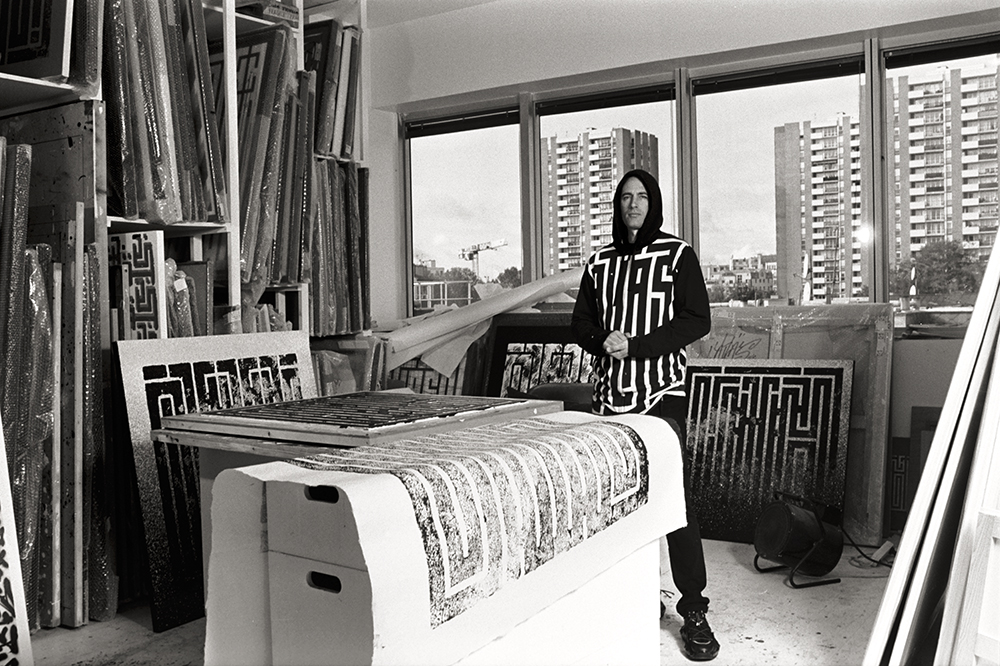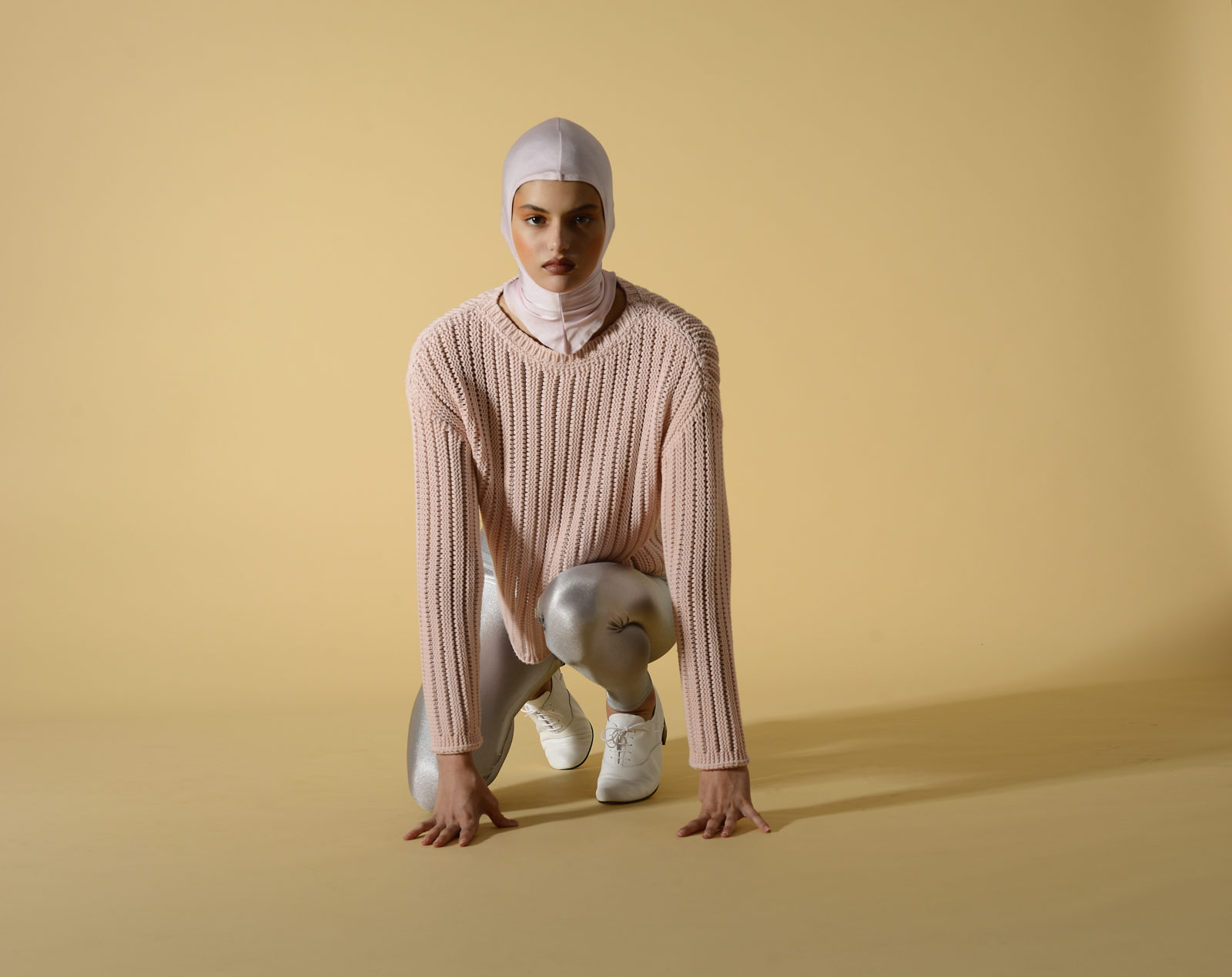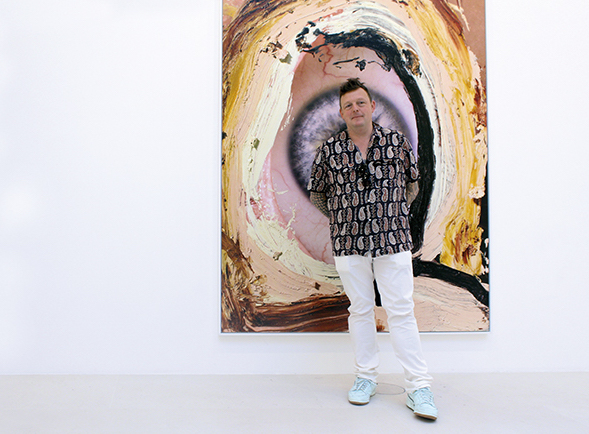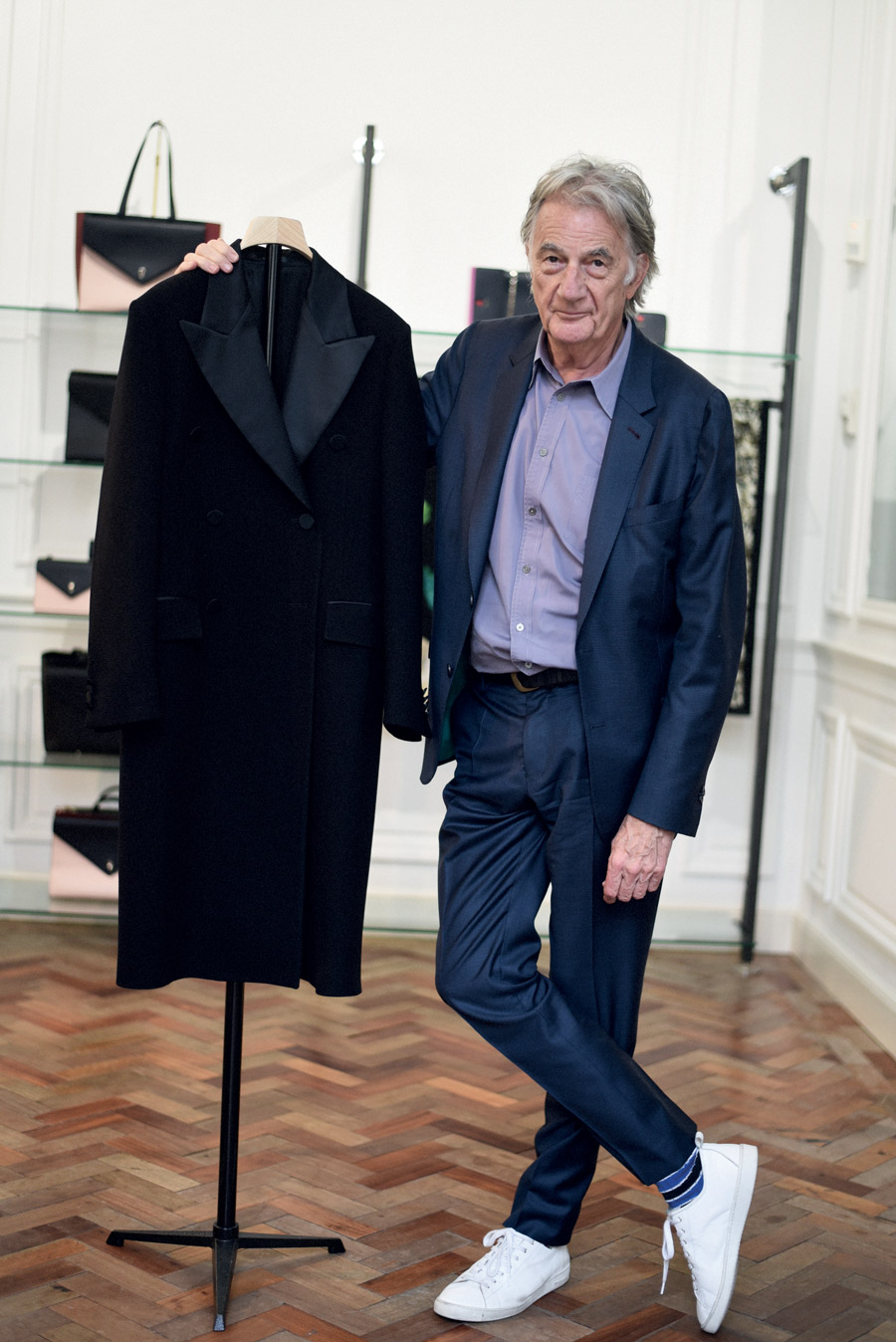
A MEETING BETWEEN SUE NABI, NICOLAS VU & ARMELLE LETURCQ
By Armelle Leturcq
On the eve of the 120th anniversary of the Coty cosmetics group, Infiniment Coty Paris stands as a bridge between the past and the future of perfumery. Conceived by Coty’s audacious General Manager, Sue Nabi, and her partner Nicolas Vu, this new line of fourteen fragrances reinvents Coty’s iconic heritage, combining scientific innovation and sustainability with a fresh artistic approach. Thanks to ultra-concentrated formulations, a revolutionary technology called Aura Moléculaire, sustainable packaging and an intrinsic link with contemporary art, Infiniment Coty Paris is diffusing a fresh olfactory emotion, a sensory experience in which each fragrance tells a personal story. Photography by Chiara Bruschini.
ARMELLE LETURCQ I love the name of the “Aristo Chypre” perfume. All fourteen juices have great names.
SUE NABI To be honest, Nicolas played a big role in choosing the names. “Aristo Chypre” is his favorite and signature perfume.
AL Did you come up with the names first and then develop the juices or vice versa?
SN We created the juices first, almost ten years ago in 2014-2015.
NICOLAS VU Yes, we started working on the notes first before naming them.
SN When the juices began to shape, we started thinking about the names. But the names truly came together in the last year, so at the very end of the process. The juices existed for nearly ten years before then names were chosen. And it is because we had plenty of time to think about the stories we wanted to tell.
AL Why ten years? That seems long.
NV A lot happened in those ten years. There was Covid and the launch of our Orveda skincare line. We also spent a lot of time formulating the juices with a few different noses.
SN Many of the notes were designed in collaboration with fragrance and flavor company Firmenich. The project took a long time to complete, since we started it at the same time as Orveda. When I left L’Oréal in 2013, Nicolas and I said to each other, “We need to come up with things we can be proud of.” So we wrote down three ideas, a make-up idea, a skincare idea and a perfume idea. The perfume idea was to invent the first perfume line that would be not only creative but also scientific. The skincare idea was to “Act with skin, not against skin”. That eventually became Orveda. As for make-up, our idea was to create customized palettes. That idea became dated after a year, so we scrapped it and kept the other two, which turned out to improve over time, like a good wine. We launched Orveda in 2017-2018, while continuing to create fragrances we would wear on our own, so the different notes we personally enjoy. Then when I started at Coty in 2020, right in the middle of the pandemic, we told ourselves that our perfume project needed to become a reality. There were several options before us, such as launching a separate brand. But upon reflection, the Coty name is still one of the most beautiful names in perfumery, and François Coty may even be considered as the inventor of modern perfumery. Coty also created the chypre family, which were the first to blend natural notes, which were predominant at the time, with synthetic notes to enhance the beauty of the former (some synthetic notes were already in use, but they did not yet play such an important role in the fragrance). It was very innovative. Integrating this perfume line into Coty, one of the world’s leading perfume companies, was also a way of concentrating the best of the company’s expertise, which was somewhat fragmented or not always used in our various license brands. Infiniment Coty Paris is honestly the pinnacle of what the Coty group can do in terms of formulation. We use formulas without dyes or UV filters – which are generally needed to prevent the juices from changing color and losing their aesthetic appeal – in order to achieve a minimalistic formula in terms of chemical ingredients. This is the very first time that the entire line has used the renowned alcohol that is obtained by transforming emissions from biotech industries and micro-organisms into alcohol. This technique also inspired us for Orveda. The resulting alcohol removes carbon dioxide from the atmosphere, thus reducing its environmental impact. Finally, we used a technology for which Coty has filed multiple patents. It consists in using a molecule derived from a plant sugar, which interacts with the different notes and releases them in a controlled way over a longer period of time than would occur with natural evaporation.
In a few words, we know today that the alpha and omega of the younger generation is longevity and sillage, meaning the trail left by the scent.
AL Do you think of this project as a collection of niche perfumes? After L’Oréal, did you want to create a more innovative, high-end project?
SN After observing the market, we realized that niche, when it appeared some twenty, thirty years ago, embodied a real counterculture to “mass-market perfumes”, including perfumes sold in perfumeries that used mass-market codes. Back then, all the money invested in a perfume went into making the juice, and there were no advertising costs. As a result, brands used highly concentrated, high-quality juices. Today, however, niche perfumes are less concentrated than mainstream perfumes. So we asked ourselves: “How can we restore the nobility of niche perfumery through a creative act, but also an act of quality?” So we decided to work on extremely concentrated juices and to apply science to boost the longevity and sillage of the fragrance. This is the very essence of exceptional perfumery. When you ask customers why they buy it, they say it comes down to two reasons: quality – “We know that the money we have invested is in the juice, not in the TV ad” – and creativity. So we wanted both.
AL And in terms of distribution, will you be distributed at high-end outlets or at Sephora, for example? Do you have your own boutique yet?
SN As it happens, our first boutique opens in Paris on March 20, 2024 in the Marais – at 5, rue des Blancs Manteaux. It is the first Coty-branded boutique in the world! It is the return of the Coty brand to boutiques.
AL Will it only carry your collection?
NV Yes. There will also be a boutique in New York, because there is a lot of demand there.
SN Nicolas is opening Orveda houses, which will have several floors and treatment booths, where people can come and learn how to care for their skin, how to nourish it and so on. He has kindly invited Infiniment Coty Paris, so it is kind of our baby, since it is the equivalent in perfume of what Orveda is in skincare. It will also be available in New York. And here in London, the line will be sold at Liberty.
AL So you are going to set up a selective distribution and then on the Internet too, I imagine?
SN Absolutely, through the Infinimentcoty.com website. NV Even though it is a bit harder to sell perfume online. SN What is fundamentally changing in relation to Nicolas’ comment is that today you have these famous influencers who are perfume experts. For that reason, we are a little less involved in the kind of phenomena we have seen in the past, where people suddenly call themselves influencers overnight, particularly in make-up. Instead, there are now influencers with real expertise, a real knowledge of ingredients, the history of perfume, olfactory families, how to make a perfume last or how to do layering. They have found a less intimidating way to talk to the younger generation about perfume. For example, they may say “You want to look like such and such a character from the Euphoria series? Buy this perfume”. “You want a fantastic perfume for going out at night and leaving your mark on the person you want to impress or on a group? Choose this fragrance”. “You want a clean morning scent that is very fresh and easy to wear with your white shirt? Go for this fragrance.” In fact, we also worked on the collection in this way, by focusing on the dawn or day notes in the form of characters. We practically personified each of the notes. I told the teams: “You won’t meet many people who wear ’Noir Encens’, for example”, as I think you will agree.
AL Yes, I hesitated between “Noir Encens” and “Soleil d’Ikosim”.
SN For me, “Noir Encens” is Neo in the Matrix, dressed in all black with black sunglasses, and a coat with a slightly Japanese silhouette like Issey Miyake or Yamamoto. These are the stories we tell and that the expert influencers in perfumery tell to get the younger generation to buy these fragrances today. These stories allow us to imagine ourselves wearing a specific perfume because they are not so traditional. Perfume allows us to become who we want to be. It is part of a panoply today. I have my sneakers, my signature sunglasses and my perfume.
AL Do you think the younger generations can afford to buy such pricey fragrances?
SN Yes, because they can also afford to buy expensive sneakers. They spend their money on things that allow them to exist socially and express themselves, so to speak.
NV I meet a lot of people who are looking for quality. It’s funny, I was chatting with an Amazon delivery guy who smelled very nice, so I asked him what fragrance he was wearing and the young man replied, “There’s a little store in such-and-such a corner of Paris that sells Oud, I make a point to buy it there.” I asked him the price and he told me that a 30 ml bottle costs €300. It is clear that people truly want to treat themselves to quality products.
SN They prefer to buy less, but better. In fact, as CEO of Coty, I talk a lot with my investors and they all ask me why perfume is the fastest-growing category in the United States, Europe and Asia, especially China. The reality is that perfume has reinvented itself. When I started at L’Oréal thirty years ago, perfume was in the hands of companies who invested most of their money in advertising and marketing, and very little in the juice. When I created “La vie est belle” at Lancôme, I decided that I would put a lot more money into the juice than we had ever done before. It was one of the most expensive juices in the L’Oréal Group at the time. As this approach became more widespread, the public rediscovered perfume as a true luxury item.
AL Interesting. And how did the connection to contemporary art come about?
SN That is all Nicolas and Sarah.
NV That is the Genesis. Sue and I originally had three projects, but we decided to work on two of them, as she told you, including the perfume project, which was very important to us, and I always wanted to work with my daughter Sarah Louis. So we looked for a way to combine her field, art, with ours, cosmetics. I have a great appreciation of art, and we had a strong urge to showcase art from all over the world through this project. I mean, a lot of different things blended together in my head, but it was basically a case of love at first sight.
SN The mantra of Nicolas, who designed the fragrance, is that the best form of sustainability is never to throw anything away. There is nothing better than something that cannot be thrown away. Remember the Quality Street chocolate boxes our moms used to keep, which eventually turned into sewing boxes and so on? Those are things that last.
AL The problem today is that we throw everything out.
NV Exactly, so you have two options: either you make something disposable, but it has to be ultra-recyclable, or even compostable and biodegradable, which is always technically complicated. Or you make objects that are so beautiful that people keep and collect them, or objects that can have a second life. And that was kind of the idea. When Nicolas was designing the perfume, he told the people drawing with him: “I want a flat surface, and I would like the perfumes to be able to stack on top of each other very seamlessly. I want the flat side to be really flat”, which is always very difficult to achieve in perfume. When you look at a glass-blown bottle, there is always a bit of movement, so in this case we really pestered the people who made the bottle so that it would be very flat, so that when you fit them all together, they look like works of art. And the other really cool thing is that each bottle is sold in a case that you can keep. It’s not that annoying kind of box that is usually really big. It’s a no-frills case made from 100% plant fiber. For example, I have been carrying it around for a year and it fits perfectly in my little toiletry bag.
AL There is no plastic at all?
NV Exactly, and it still protects the fragrance.
AL What material is the cap made out of?
NV It’s Zamak, which is a metal that stays cold. We are currently thinking about how to recycle the caps. There is a generation of artists now who are working on recyclable materials. But the bottles are refillable, so of course they can last forever, same with the box.
AL How do you manage to juggle this project, which is a very specialized collection, with the other brands you manage at Coty?
NV Honestly, it’s the same job, perhaps with a little more freedom in this project, since we started from scratch. And it is a way for me, as the head of Coty, to maintain a connection to the real world of what our business is all about. I think that a lot of managers at large groups are totally cut-off from what forms the essence of a beauty group, namely the creation of fragrances that smell good, products and skincare formulas that feel good on the skin, or make-up that lasts a very long time. For me, this connection to the essence of our business is very important, even essential. I see a lot of “cross-fertilization” between what we have learned with Nicolas here and what we do in our other professions.











